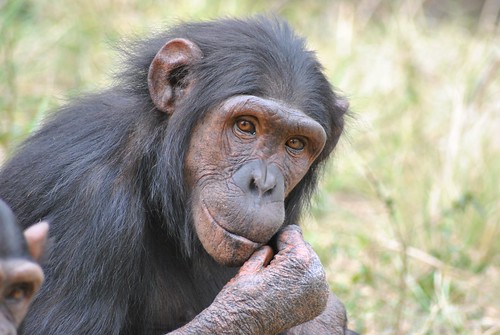We haven’t succeeded in killing off all our primate relatives yet. A group of scientists has discovered an enormous society of chimpanzees deep in the forests of the DRC and Central African Republic. There may be as many as ten thousand chimps previously unknown to researchers, with their own behavior patterns and communicative vocabulary.

The Bili-Uele forest chimps are very distinctive, as footage from eight months’ worth of motion-activated cameras shows. They’re larger. They build ground nests. They eat snails.
They use tools to gather insects to eat:
And their entire local ecosystem is one that has not been discovered or documented. While the chimps were first detected in 2007, a more detailed report only came out this month, in “Absence of evidence is not evidence of absence: Discovery of a large, continuous population of Pan troglodytes schweinfurthii in the Central Uele region of northern DRC”, a paper published in the scientific journal Biological Conservation. If you want to read the whole paper, it’ll cost you forty bucks; you may be better off sticking with the summaries in the popular press. Meanwhile, here’s the abstract:
With great ape populations in decline across much of their range, it is crucial to obtain a global picture of their distribution and abundance, in order to guide conservation activities and to provide baseline data against which to monitor their trends. Although great apes are popular, charismatic species, we still do not possess a complete understanding of their distribution and abundance, which hinders their long-term protection. We highlight this problem by providing information on the distribution and abundance of the Eastern chimpanzee (Pan troglodytes schweinfurthii) in the northern Democratic Republic of the Congo (DRC), a region which has until now received little attention. We conducted a standing crop nest survey in the Bili area in 2005 and exploratory reconnaissance walks (recces) across the Bas-Uele region between 2004 and 2009. At Bili, the nest encounter rate in the remote forest was 4.84 nests per km (CI = 2.78–8.55) and in the area closer to the road it was 1.92 nests per km (CI = 1.08–3.43). In 2012, we repeated a part of the original transect survey and found that the nest encounter rate had remained stable over that period. On our recce walks across the region, we encountered chimpanzee nests in all forests surveyed, and within 13 km of the largest population centers. Our results suggest that the Central Uele landscape and neighboring regions are home to one of the largest remaining continuous populations of Eastern chimpanzees, that extends across at least 50,000 km2, likely representing thousands of individuals, but which is falling under increasing pressure from habitat destruction, mining and the bushmeat trade. This population has until now remained hidden from researchers and is not protected. Our results reflect gaps in our current understanding of ape distribution and abundance, and highlight the importance of obtaining more sound and complete data before assessing species status and making recommendations to guide conservation efforts.
Those cameras gave lots of documentation of other forest animals, some hardly ever seen. There is a YouTube channel dedicated to these videos, but I’ll share a few here:
A leopard, closer than I ever want to get — destroying the camera enclosure.
An aardvark or two. I like aardvarks, don’t you?
Elephants, just passing through.
Alas, this piece of good news comes with a lot of sad caveats:
However, while the chimp numbers have apparently remained stable, the numbers of forest elephants have crashed by half due to poaching. The slaughter, to feed the highly lucrative illegal ivory trade, mirrors the bloody picture across central Africa, where two-thirds of all forest elephants have been killed in the last decade. “We found the burned skulls of a mother and baby skull at a poachers camp,” says Hicks.
“The area is at great risk of being opened up,” says John Hart, one of the team and who has spent decades in DRC at the Lukuru Wildlife Research Foundation. The team’s work was interrupted previously by gunmen protecting illegal gold mining operations in nearby areas but the security situation is getting worse, Hart told the Guardian.
(snip)
The chimps are an endangered species and fully protected in DRC law. “But it is only a law on paper,” says Hicks, who identifies both official security forces and militia as the source of much of the danger, as well as endemic corruption. “I think the military are giving guns to the poachers.” He says the forest and the chimp mega-culture it contains are currently completely unprotected.
In other higher primate news, this video from the Jane Goodall Institute is beautiful and very moving. Get out your handkerchiefs:
Here’s what a lot of chimp vocalization sounds like: